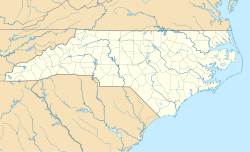Fayetteville Street Historic District
In this article, we will explore the topic of Fayetteville Street Historic District in depth, addressing its importance in today's society and its relevance in various areas. Fayetteville Street Historic District has become a topic of growing interest, since its impact extends to different areas of knowledge and daily life. Throughout these pages, we will analyze the main characteristics of Fayetteville Street Historic District, as well as its evolution over time and its influence in different contexts. Through a comprehensive approach, we will try to provide a panoramic view of Fayetteville Street Historic District, exploring its many facets and its relevance today.
Fayetteville Street Historic District | |
 Fayetteville Street, c 1910s | |
| Location | Roughly 100-400 blocks of Fayetteville, 00-100 blocks of W. Hargett, 00 blk. of W. Martin, 100-400 S. Salisbury Sts., Raleigh, North Carolina |
|---|---|
| Coordinates | 35°46′39″N 78°38′21″W / 35.77750°N 78.63917°W |
| Area | 12 acres (4.9 ha) |
| Architect | multiple |
| NRHP reference No. | 07001412[1] |
| Added to NRHP | February 27, 2008 |
The Fayetteville Street Historic District in Raleigh, North Carolina is a historic district listed on the National Register of Historic Places (NRHP). The District includes the 100–400 blocks of Fayetteville Street, the 00–100 blocks of the south side of West Hargett Street, the 00 block of the north side of West Martin Street, and the 100–400 blocks of South Salisbury Street.[2]
The District, composed mostly of commercial establishments, is home to eleven buildings listed on the NRHP. They include:[2]
- Masonic Temple Building, 133 Fayetteville St.
- Briggs Hardware Building, 220 Fayetteville St.
- Lumsden-Boone Building, 226 Fayetteville St.
- Mahler Building, 228 Fayetteville St.
- Carolina Trust Building, 230 Fayetteville St.
- Federal Building, 314 Fayetteville St.
- Sir Walter Raleigh Hotel, 400 Fayetteville St.
- Raleigh Bank and Trust Company Building, 5 W. Hargett St.
- Odd Fellows Building, 19 W. Hargett St.
- McLellan's Five and Dime Annex, 14 W. Martin St.
- Capital Club Building, 16 W. Martin St.
See also
References
- ^ "National Register Information System". National Register of Historic Places. National Park Service. July 9, 2010.
- ^ a b "Citizens Invited To Comment On Fayetteville Street Historic District Nomination". City of Raleigh. Retrieved April 18, 2008.[permanent dead link]
External links
![]() Media related to Fayetteville Street Historic District at Wikimedia Commons
Media related to Fayetteville Street Historic District at Wikimedia Commons
- National Register Historic Districts in Raleigh, North Carolina, RHDC
- Fayetteville Street Historic District, RHDC



